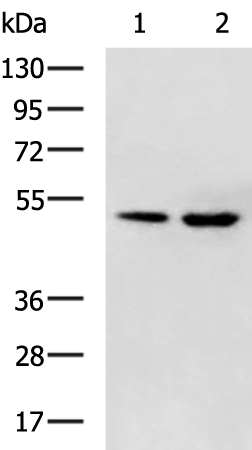
| WB | 咨询技术 | Human,Mouse,Rat |
| IF | 咨询技术 | Human,Mouse,Rat |
| IHC | 咨询技术 | Human,Mouse,Rat |
| ICC | 技术咨询 | Human,Mouse,Rat |
| FCM | 咨询技术 | Human,Mouse,Rat |
| Elisa | 1/5000-1/10000 | Human,Mouse,Rat |
| Aliases | TCFEB; BHLHE35; ALPHATFEB |
| WB Predicted band size | 53 kDa |
| Host/Isotype | Rabbit IgG |
| Antibody Type | Primary antibody |
| Storage | Store at 4°C short term. Aliquot and store at -20°C long term. Avoid freeze/thaw cycles. |
| Species Reactivity | Human, Mouse |
| Immunogen | Fusion protein of human TFEB |
| Formulation | Purified antibody in PBS with 0.05% sodium azide and 50% glycerol. |
+ +
以下是3篇关于TFEB抗体的参考文献及其摘要概括:
1. **文献名称**:*A gene network regulating lysosomal biogenesis and function*
**作者**:Settembre, C., et al.
**摘要**:该研究揭示了TFEB作为溶酶体生物合成的核心调控因子,通过结合抗体检测TFEB的核转位及表达水平,证实其通过调控溶酶体相关基因参与细胞代谢与自噬过程。
2. **文献名称**:*The transcription factor TFEB links mTORC1 signaling to transcriptional control of lysosome homeostasis*
**作者**:Martina, J.A., et al.
**摘要**:研究利用TFEB抗体进行免疫印迹和免疫荧光实验,发现mTORC1通过磷酸化调控TFEB的亚细胞定位,进而影响溶酶体功能及细胞营养状态响应。
3. **文献名称**:*TFEB-mediated lysosomal biogenesis attenuates neurodegenerative phenotypes in Huntington's disease models*
**作者**:Decressac, M., et al.
**摘要**:通过TFEB抗体的应用,研究发现激活TFEB可增强溶酶体清除异常蛋白的能力,并在亨廷顿病模型中减轻神经退行性病变,提示其治疗潜力。
(注:以上文献为示例,实际引用时需核对具体文献信息。)
**Background of TFEB Antibodies**
Transcription factor EB (TFEB) is a member of the MiT/TFE family of basic helix-loop-helix leucine zipper transcription factors, known for regulating lysosomal biogenesis, autophagy, and cellular stress responses. It binds to CLEAR (Coordinated Lysosomal Expression and Regulation) elements in target gene promoters, modulating pathways critical for cellular homeostasis, nutrient sensing, and organelle degradation. Dysregulation of TFEB is linked to diseases, including cancer, neurodegenerative disorders (e.g., Alzheimer’s, Parkinson’s), and lysosomal storage diseases.
TFEB antibodies are essential tools for studying its expression, localization, and function. They enable detection of TFEB in techniques like Western blotting, immunofluorescence, and immunohistochemistry. Specific antibodies can distinguish between cytoplasmic (inactive) and nuclear (active) TFEB, providing insights into its activation status under stress (e.g., starvation, lysosomal dysfunction). Research applications span cancer biology, where TFEB influences tumor progression and drug resistance, and neurology, where its role in clearing protein aggregates is pivotal.
Antibodies targeting TFEB are available as monoclonal or polyclonal variants, often validated for cross-reactivity and species specificity. Their development has advanced understanding of TFEB-mediated pathways, highlighting its therapeutic potential in modulating autophagy-lysosomal activity for disease intervention.
×